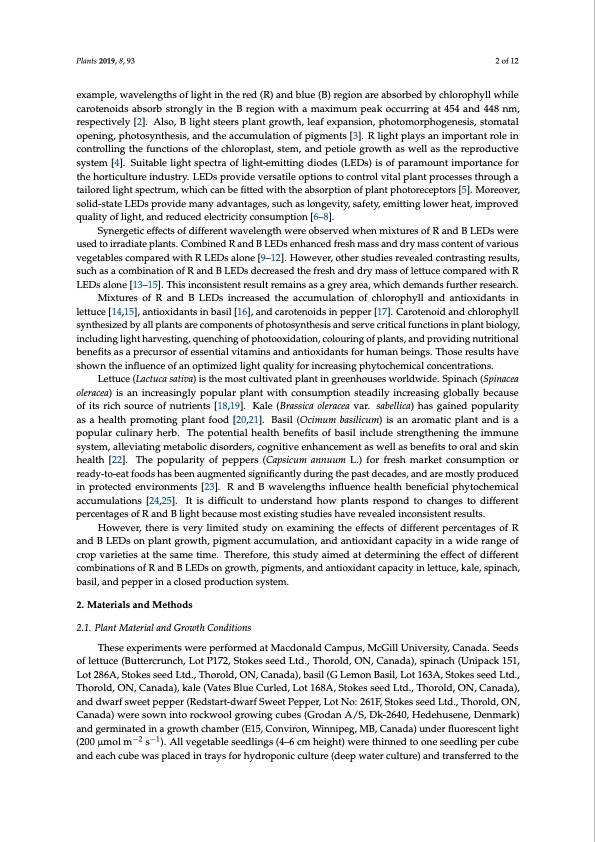
PDF Publication Title:
Text from PDF Page: 002
Plants 2019, 8, 93 2 of 12 example, wavelengths of light in the red (R) and blue (B) region are absorbed by chlorophyll while carotenoids absorb strongly in the B region with a maximum peak occurring at 454 and 448 nm, respectively [2]. Also, B light steers plant growth, leaf expansion, photomorphogenesis, stomatal opening, photosynthesis, and the accumulation of pigments [3]. R light plays an important role in controlling the functions of the chloroplast, stem, and petiole growth as well as the reproductive system [4]. Suitable light spectra of light-emitting diodes (LEDs) is of paramount importance for the horticulture industry. LEDs provide versatile options to control vital plant processes through a tailored light spectrum, which can be fitted with the absorption of plant photoreceptors [5]. Moreover, solid-state LEDs provide many advantages, such as longevity, safety, emitting lower heat, improved quality of light, and reduced electricity consumption [6–8]. Synergetic effects of different wavelength were observed when mixtures of R and B LEDs were used to irradiate plants. Combined R and B LEDs enhanced fresh mass and dry mass content of various vegetables compared with R LEDs alone [9–12]. However, other studies revealed contrasting results, such as a combination of R and B LEDs decreased the fresh and dry mass of lettuce compared with R LEDs alone [13–15]. This inconsistent result remains as a grey area, which demands further research. Mixtures of R and B LEDs increased the accumulation of chlorophyll and antioxidants in lettuce [14,15], antioxidants in basil [16], and carotenoids in pepper [17]. Carotenoid and chlorophyll synthesized by all plants are components of photosynthesis and serve critical functions in plant biology, including light harvesting, quenching of photooxidation, colouring of plants, and providing nutritional benefits as a precursor of essential vitamins and antioxidants for human beings. Those results have shown the influence of an optimized light quality for increasing phytochemical concentrations. Lettuce (Lactuca sativa) is the most cultivated plant in greenhouses worldwide. Spinach (Spinacea oleracea) is an increasingly popular plant with consumption steadily increasing globally because of its rich source of nutrients [18,19]. Kale (Brassica oleracea var. sabellica) has gained popularity as a health promoting plant food [20,21]. Basil (Ocimum basilicum) is an aromatic plant and is a popular culinary herb. The potential health benefits of basil include strengthening the immune system, alleviating metabolic disorders, cognitive enhancement as well as benefits to oral and skin health [22]. The popularity of peppers (Capsicum annuum L.) for fresh market consumption or ready-to-eat foods has been augmented significantly during the past decades, and are mostly produced in protected environments [23]. R and B wavelengths influence health beneficial phytochemical accumulations [24,25]. It is difficult to understand how plants respond to changes to different percentages of R and B light because most existing studies have revealed inconsistent results. However, there is very limited study on examining the effects of different percentages of R and B LEDs on plant growth, pigment accumulation, and antioxidant capacity in a wide range of crop varieties at the same time. Therefore, this study aimed at determining the effect of different combinations of R and B LEDs on growth, pigments, and antioxidant capacity in lettuce, kale, spinach, basil, and pepper in a closed production system. 2. Materials and Methods 2.1. Plant Material and Growth Conditions These experiments were performed at Macdonald Campus, McGill University, Canada. Seeds of lettuce (Buttercrunch, Lot P172, Stokes seed Ltd., Thorold, ON, Canada), spinach (Unipack 151, Lot 286A, Stokes seed Ltd., Thorold, ON, Canada), basil (G Lemon Basil, Lot 163A, Stokes seed Ltd., Thorold, ON, Canada), kale (Vates Blue Curled, Lot 168A, Stokes seed Ltd., Thorold, ON, Canada), and dwarf sweet pepper (Redstart-dwarf Sweet Pepper, Lot No: 261F, Stokes seed Ltd., Thorold, ON, Canada) were sown into rockwool growing cubes (Grodan A/S, Dk-2640, Hedehusene, Denmark) and germinated in a growth chamber (E15, Conviron, Winnipeg, MB, Canada) under fluorescent light (200 μmol m−2 s−1). All vegetable seedlings (4–6 cm height) were thinned to one seedling per cube and each cube was placed in trays for hydroponic culture (deep water culture) and transferred to thePDF Image | Blue Light added with Red LEDs Enhance Growth Characteristics

PDF Search Title:
Blue Light added with Red LEDs Enhance Growth CharacteristicsOriginal File Name Searched:
plants-08-00093.pdfDIY PDF Search: Google It | Yahoo | Bing
Cruise Ship Reviews | Luxury Resort | Jet | Yacht | and Travel Tech More Info
Cruising Review Topics and Articles More Info
Software based on Filemaker for the travel industry More Info
The Burgenstock Resort: Reviews on CruisingReview website... More Info
Resort Reviews: World Class resorts... More Info
The Riffelalp Resort: Reviews on CruisingReview website... More Info
| CONTACT TEL: 608-238-6001 Email: greg@cruisingreview.com | RSS | AMP |